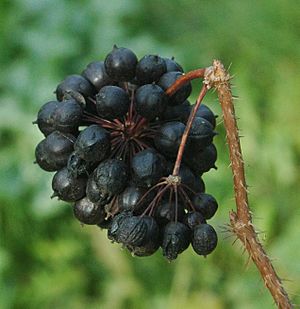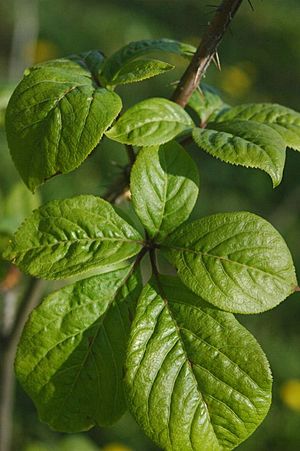Eleutherococcus senticosus facts for kids
Quick facts for kids Eleutherococcus senticosus |
|
|---|---|
 |
|
| Scientific classification | |
| Genus: |
Eleutherococcus
|
| Species: |
senticosus
|
| Synonyms | |
|
|
Eleutherococcus senticosus is a small, woody plant that grows as a shrub. It belongs to the family Araliaceae. This plant is originally from Northeastern Asia. People call it by many names, like Siberian ginseng or eleuthero. It's also known as devil's bush or ciwujia. For a long time, people have used parts of this plant in folklore and traditional Chinese medicine. Today, you can find extracts from its roots sold as supplements or in beauty products. They are often called Siberian ginseng.
Contents
What's in a Name?
The scientific name, Eleutherococcus, comes from Greek words meaning "free-berried." The second part, senticosus, is Latin for "thorny" or "full of thorns." So, its name describes a thorny plant with berries that are not clustered together. It's important to know that this plant is not the same as American ginseng or Asian ginseng. It has many different common names depending on where it grows.
Where It Grows
This plant grows in mountain forests where there are mixed trees or conifer trees. It often forms a low layer of plants under taller trees. You can also find it in groups along the edges of forests. Sometimes, it grows near rivers or at the bottom of cliffs. Its natural home is in East Asia, including China, Japan, and Russia.
Eleutherococcus senticosus can grow in many types of soil. It likes sandy, loamy, or heavy clay soils. It doesn't mind if the soil is acidic, neutral, or alkaline. It can even grow in soil that doesn't have many nutrients. This plant can handle full sun or partial shade. It can also tolerate some air pollution. It is a deciduous shrub, meaning it loses its leaves in the fall. It grows slowly and can reach about 2 metres (6.6 ft) tall. Its flowers appear in July and are pollinated by insects.
Plant Parts and What's Inside
The roots of E. senticosus are thin, usually less than 0.5 centimetres (0.20 in) wide. They can be straight or branched. The roots are dark brown and have a smooth surface. The outer bark is tightly attached to the inner wood.
Scientists have studied the extracts made from these roots. They found important natural compounds inside. These include things like lignans and sesamin. The berries of the plant also contain different polyphenols. These are natural chemicals that can be good for you. The berries also have important minerals like calcium, magnesium, and potassium.
The leaves of Eleutherococcus senticosus also contain special oils. These oils have different smells and properties. Some of the main parts of these oils are α-bisabolol and β-caryophyllene.
Traditional Uses and Safety
For a long time, people have used extracts from the root of Eleutherococcus senticosus in alternative and traditional healing practices. They believed it could help with many health issues. However, it's important to know that not all of these claims have strong scientific proof.
The WHO says that this plant may be used as a "prophylactic and restorative tonic." This means it might help prevent illness and restore strength. It could also help improve mental and physical abilities when someone feels weak, tired, or is recovering from an illness. Some early studies looked at if it could fight germs or reduce stress. But these studies were not very strong, so we don't have scientific proof for these effects yet.
It's important to be careful when using E. senticosus. Some people should avoid it or talk to a doctor first. This includes people with high blood pressure, sleep apnea, or heart disease. People with certain mental illnesses or a weak immune system should also be careful. Pregnant or breastfeeding women should not use it. Also, if you are taking certain medicines, like digoxin, it could cause problems. Taking too much of this plant might make some people feel irritable, confused, or anxious. It could also cause insomnia, which is trouble sleeping.
See also
 In Spanish: Eleuterococo para niños
In Spanish: Eleuterococo para niños


